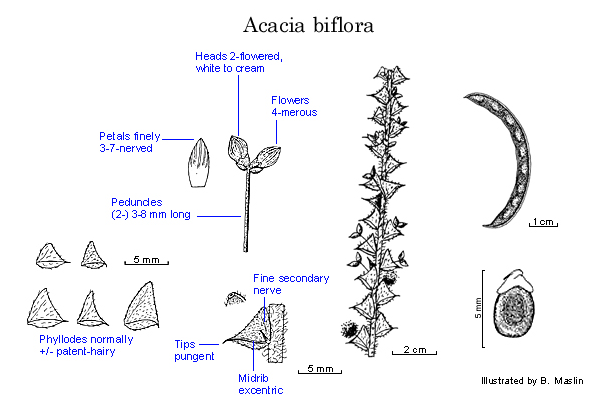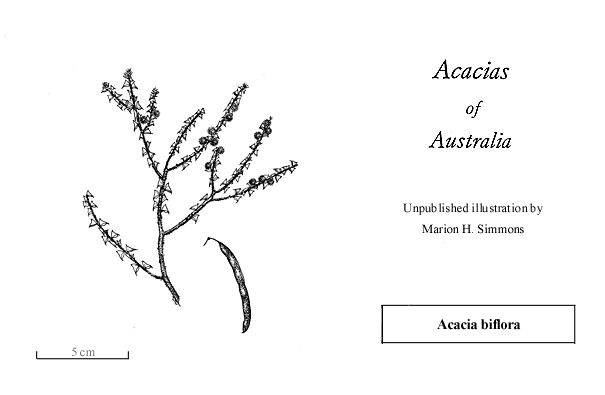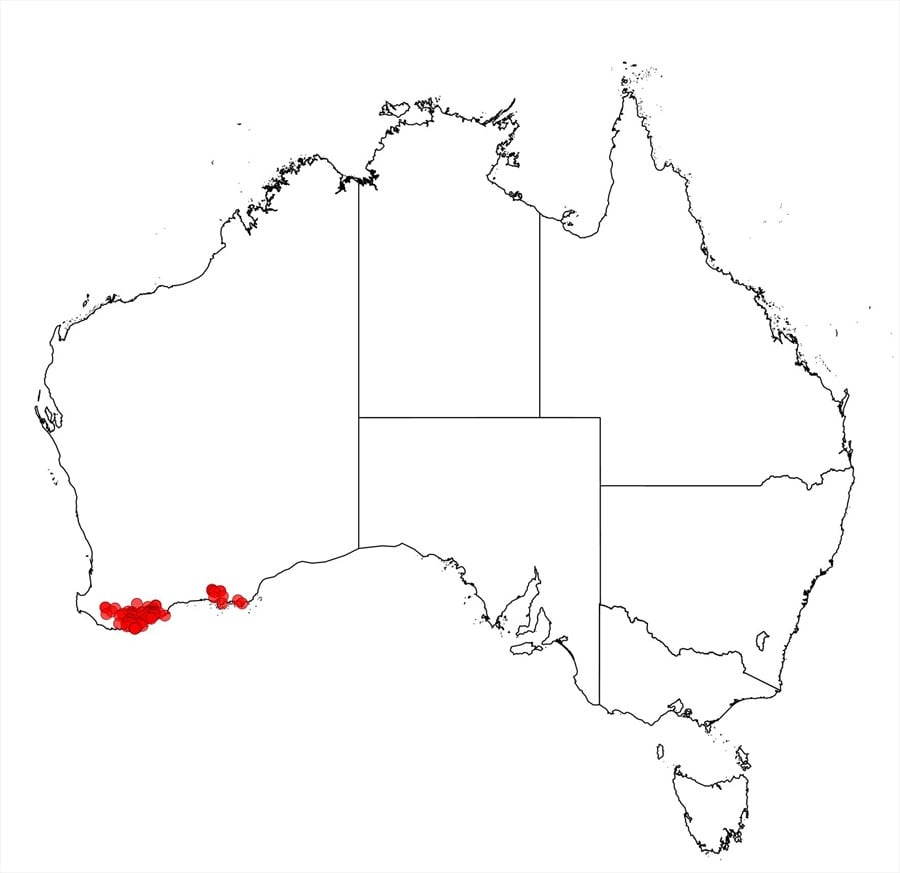Acacia biflora R.Br.
WATTLE
Acacias of Australia
Common Name
Two-flowered Acacia
Family
Fabaceae
Distribution
Occurs from the Stirling Ra. Natl Park–Albany area E to near Jerramungup and Bremer Bay with disjunct occurrences in the Scaddan area and at Lucky Bay, south-western W.A.
Description
Shrub 0.3–0.6 m high. Branchlets sparsely to densely puberulous to shortly pilose. Phyllodes inequilateral, obtriangular to obdeltate with a prominent gland-bearing angle on adaxial margin, with adaxial proximal margin ±contiguous with branchlet, 3–7 mm long and 3–8 mm wide, may reach 15 mm long and wide on old stems, pungent, glabrous or hairy; midrib near abaxial margin, with a minor nerve extending from base towards the gland. Inflorescences simple, 1 per axil; peduncles 3–8 mm long, glabrous to sparsely hairy; heads globular, 2-flowered, white to cream; buds abruptly acute. Flowers 4-merous; sepals c. 3/4-united, with broadly triangular lobes; petals glabrous, ±obscurely 3–7-nerved at apices. Pods narrowly oblong, curved, to 5.5 cm long, 4–5 mm wide, coriaceous-crustaceous, glabrous; margins thick. Seeds longitudinal, ±oblong, 3–3.5 mm long, glossy, greyish brown; aril terminal.
Habitat
Usually grows in sand in woodland, low mallee scrub or shrubland.
Specimens
W.A.: Swan R., J.Drummond (?4:) 2 (BM, G, G-DC, K, MEL, OXF, P, PERTH, W); 19.5 km S of Grass Patch towards Esperance, B.R.Maslin 2507 (PERTH); 16 km S of Jerramungup towards Albany, B.R.Maslin 2589 (CANB, K, PERTH); 2 km W of Lake Carabundup, A.E.Orchard 4391 (PERTH).
Notes
Acacia biflora, together with A. chrysocephala, A. divergens, A. incrassata, A. mooreana, A. phlebopetala and A. robinae comprise the ‘A. biflora group’, fide B.R.Maslin, Nuytsia 2: 270 (1978). These species are similar vegetatively but readily distinguished by inflorescence and flower characters. Acacia biflora is recognised by a combination of the following features: heads white to cream and 2-flowered, peduncles 3–8 mm long, petals 2–3.5 mm long and 3–7-nerved at apices. The species with which A. biflora is most likely to be confused are A. chrysocephala and A. robinae. Specimens from the Fitzgerald R. Natl Park combine phyllodes of A. biflora with flowers of A. robinae.
FOA Reference
Data derived from Flora of Australia Volumes 11A (2001), 11B (2001) and 12 (1998), products of ABRS, ©Commonwealth of Australia
Author
B.R.Maslin
This identification key and fact sheets are available as a mobile application:
URL: https://apps.lucidcentral.org/wattle/
© Copyright 2018. All rights reserved.


 Acacia biflora road to Bluff Knoll, Stirling Range, WA
Acacia biflora road to Bluff Knoll, Stirling Range, WA







